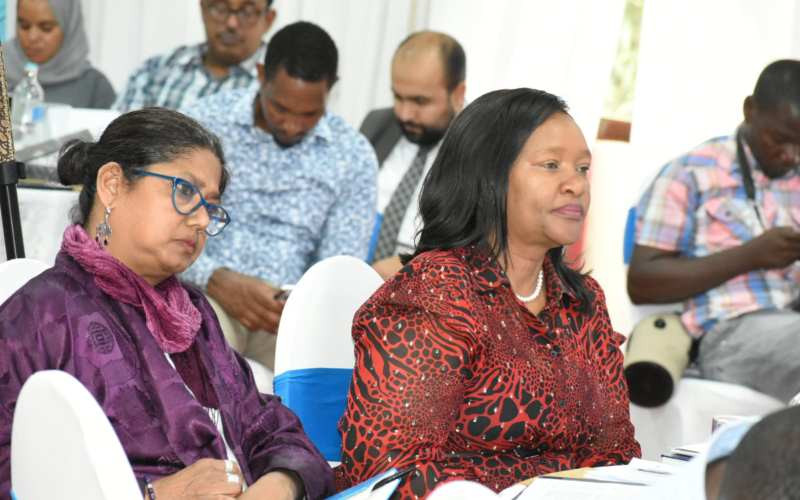UNICEF Kenya Representative Shaheen Nilofer and CS for Arid and Semi-Arid lands and East African Communities Developments Rebecca Miano.[Samson Wire, Standard]
Governors from key Arid and Semi-Arid (ASAL) counties and representatives of various humanitarian agencies, including the United Nations Children’s Fund (UNICEF), World Food Programme (WFP), African Development Bank (AFDB), and Finn Church Aid (FCA) on Thursday held a roundtable engagement to review and discuss efforts towards resilience building within ASAL regions.
The delegation included Rebecca Miano, the Cabinet Secretary for the East African Community, Arid and Semi-Arid Lands and Regional Development; governors Nathif Jama Adan, Garissa; Mohamed Adan Khalif, Mandera; Abdi Ibrahim Hassan, Isiolo; Muhamed Ali, Marsabit; Ahmed Abdullahi, Wajir, and Deputy governor Isiolo. Also present were the United Nations resident coordinator, Stephen Jackson, and UNICEF Kenya representative, Shaheen Nilofer.
The governors cited a chronic lack of water as the main reason ASAL areas continue to bear the brunt of climate change, yet seasonal rains often leave floods in their wake.
“There’s a need for a firm and affirmative action from the National government to transform all the talk into action and invest into long-term solutions,” said the host governor, Nathif Jama.
Wajir governor Ahmed Abdullahi called for building more water reservoirs by the government, the private sector and humanitarian partners even as heavy rains are anticipated to promote agricultural activities and prevent the water from going down the drain and later bemoaning drought every four to five years.
CS Miano lamented the high cost of rapid drought response efforts and called for quick efforts to establish long-term solutions to the ever-changing and extreme climate change effects in ASAL regions. She, however, expressed the national government’s willingness to support affected county governments to build resilience.
“We need a paradigm shift and come up with impactful projects and resilience programs such as the building of dams and irrigation projects,” said Miano.
“Helping people survive climate change effects requires a long-term commitment from governments, donors, institutions and NGOs,” said Shaheen Nilofer, the UNICEF Kenya representative.
“We have repaired more than 500 boreholes and are building aquifers, but there’s a need for more resources to have at least 70 per cent of ASAL dry regions have access to water. This can easily be achieved with integrated resources, systems and partnerships.”
Currently, water access within the seven ASALs is at 59 per cent.
The delegates also visited three project sites: an NGO, WomenKind, in Garissa town to assess child protection initiatives. At Iftin Sub-county Hospital, they oversaw the delivery of health, nutrition/WASH-Primary healthcare programmes at the health facility level. At Garissa Primary School, they witnessed the enrollment drive for the Out-of-School Program and the mainstreaming and integration of learners with disabilities alongside their peers without disabilities.

















.png)


Discussion about this post